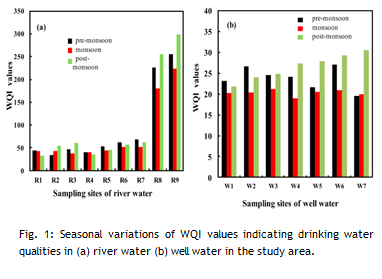 The current river basin monitoring study investigates the standards of the quality of the river and well water in a biodiversity-rich Netravati River basin in Karnataka state, India. Water samples were collected from 16 major sampling sites during pre-monsoon (April), monsoon (August) and post-monsoon (October) seasons in 2017 to ascertain its physico-chemical parameters. The results of the tests were compared with maximum permissible limits proposed by the World Health Organisation drinking water guidelines. The Water Quality Index (WQI) and the Irrigation Water Quality Index (IWQI) using parameters such as Sodium Percentage (Na %), Magnesium Hazard (MH), Permeability Index (PI), Sodium Absorption Ratio (SAR) and Residual Sodium Carbonate (RSC) have been determined to provide a better understanding of its drinking and irrigation water quality. The interpreted WQI values of the water in Netravati River vary from 33.21 to 298.66, which fall in the range of excellent to very poor drinking water quality. In the case of well water, 100% falls under the excellent category. Multiple statistical methods like Principal Component Analysis (PCA) and Pearson correlation analysis were used, and the results of PCA were found to be in a correlation with the results of the Pearson correlation analysis method. The study, as a whole, highlights the importance of the application of PCA, WQI and IWQI as standard methods to evaluate the quality of water. The results of the present study could be used to contemplate regulations to improve the water quality standard and help people living in and around the river basin to understand the current status of the water quality they use for various purposes.
The current river basin monitoring study investigates the standards of the quality of the river and well water in a biodiversity-rich Netravati River basin in Karnataka state, India. Water samples were collected from 16 major sampling sites during pre-monsoon (April), monsoon (August) and post-monsoon (October) seasons in 2017 to ascertain its physico-chemical parameters. The results of the tests were compared with maximum permissible limits proposed by the World Health Organisation drinking water guidelines. The Water Quality Index (WQI) and the Irrigation Water Quality Index (IWQI) using parameters such as Sodium Percentage (Na %), Magnesium Hazard (MH), Permeability Index (PI), Sodium Absorption Ratio (SAR) and Residual Sodium Carbonate (RSC) have been determined to provide a better understanding of its drinking and irrigation water quality. The interpreted WQI values of the water in Netravati River vary from 33.21 to 298.66, which fall in the range of excellent to very poor drinking water quality. In the case of well water, 100% falls under the excellent category. Multiple statistical methods like Principal Component Analysis (PCA) and Pearson correlation analysis were used, and the results of PCA were found to be in a correlation with the results of the Pearson correlation analysis method. The study, as a whole, highlights the importance of the application of PCA, WQI and IWQI as standard methods to evaluate the quality of water. The results of the present study could be used to contemplate regulations to improve the water quality standard and help people living in and around the river basin to understand the current status of the water quality they use for various purposes.
Bibliographic Info: Sandhya Sudhakaran, Harsha Mahadevan, Arun, V., Krishnakumar, A., Anoop Krishnan, K. [2020]. A multivariate statistical approach in assessing the quality of potable and irrigation water environs of the Netravati river basin (India). Groundwater for Sustainable Development, Vol. 11, Art. 100462. https://doi.org/10.1016/j.gsd.2020.100462




 RTI Act
RTI Act
